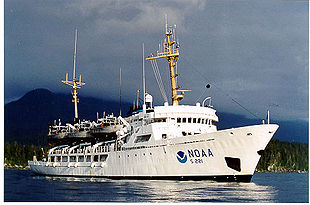- NOAAS Rainier (S 221)
-

NOAAS Rainier (S 221)Career (United States)  _
_

Name: Rainier (S 221) Namesake: Mount Rainier in Washington Builder: Aerojet-General Shipyards, Jacksonville, Florida Launched: March 1967 Acquired: April 1968 (delivered) Commissioned: October 1968 Decommissioned: 1995 Recommissioned: January 1999 Homeport: Seattle, Washington Status: Active Notes: Served in United States Coast and Geodetic Survey 1968-1970
Served in National Oceanic and Atmospheric Administration 1970-1995 and from 1999General characteristics Class and type: hydrographic survey ship Tonnage: 1,591 gross register tons
578 net register tonsDisplacement: 1,800 tons Length: 70.4 m (231 ft) Beam: 12.8 m (42 ft) moulded Draft: 4.4 m (14 ft) maximum Installed power: 2,400 shp (1.8 MW) Propulsion: Two 1,200 hp (0.89 MW) General Motors geared diesel engines, 2 shafts, 107,000 US gallons (410,000 L) fuel; one 200 hp (0.15 MW) Detroit Diesel/Bird Johnson geared through-hull bow thruster Speed: 12 to 12.5 knots (22 to 23.2 km/h) (cruising) Range: 5,898 nautical miles (10,923 km) Endurance: 22 days Boats and landing
craft carried:Six survey launches, two small open boats Complement: 49 (10 NOAA Corps officers, 4 licensed engineers, and 35 other crew members), plus up to 4 scientists[1] Notes: Ice-strengthened hull; 300 kilowatts electrical power plus 75-kilowatt emergency generator NOAA Ship Rainier (S 221) is a US National Oceanic and Atmospheric Administration survey vessel.
 NOAAS Rainier (S 221) with her namesake, Mount Rainier, in the background.
NOAAS Rainier (S 221) with her namesake, Mount Rainier, in the background.
Rainier was built at the Aerojet-General Shipyards in Jacksonville, Florida, the sister ship of NOAA Ship Fairweather (S 220) and retired NOAA Ship Mount Mitchell (S 222). She was launched in March 1967, delivered to NOAA in April 1968, and commissioned in October 1968. She is named for Mount Rainier in the state of Washington.
Rainier's ice-hardened hull is 231 feet (70 m) long. She has 79 bunk spaces. Capacity for 59 people to eat at time can be found in the three mess rooms and officer's wardroom. She carries a complement of 53—10 NOAA Corps officers, four licensed engineers, and 39 other crew members—plus up to four scientists. Seven of the crew are certified NOAA divers.
The deck equipment features one winch, two fixed cranes, and an A-frame. This equipment gives the Rainier a lifting capacity of up to 5,000 pounds (2,200 kg) as well 30,000 feet (9,100 m) of cable that can pull up to 1,000 pounds (453 kg).
She has one lab of 240 square feet (22 m2). The ship is equipped with an intermediate depth multibeam swath survey system. The vessel carries six aluminum survey launches equipped with multibeam swath and single beam echo sounders and a hydrographic data acquisition system. There are an additional three small support boats.
Among the scientific equipment are five conductivity, temperature, depth (CTD) sensors, one side-scan sonar unit, and sediment sampling equipment.
NOAA describes Rainier as "the most productive hydrographic platform in the world."[2]
Notes
- ^ Per Combat Fleets of the World 2007, the complement is 69 (12 NOAA Corps officers, 5 licensed civilian officers and 52 other crew members) plus up to 4 scientists.
- ^ NOAA Marine Operations (at http://www.moc.noaa.gov/ra/index.html).
External links
- "NOAA Ship RAINIER". May 5, 2004. http://www.moc.noaa.gov/ra/index.html. Retrieved May 9, 2006.
Categories:- Ships of the National Oceanic and Atmospheric Administration
- Survey ships of the United States
- Ships built in Florida
- 1967 ships
- Washington (state)-related ships
Wikimedia Foundation. 2010.
